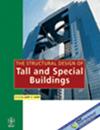Optimization of beam parameters for coupling beam pile structure foundations under vertical loading
IF 1.3
3区 工程技术
Q3 CONSTRUCTION & BUILDING TECHNOLOGY
引用次数: 1
Abstract
The coupling beam pile structure is a new type of foundation for high‐rise buildings that can be easily constructed. The vertical load‐bearing characteristics of the coupling beam pile structure are examined using indoor model tests and numerical calculations to optimize the beam structure's parameters. The validity of the finite element model is then confirmed, and the beam structure's width, length, and stiffness are changed to examine their effects on the load‐bearing capacity. The results show that the load–settlement curve of the structure varies slightly, with a 45.10% increase in load‐carrying capacity compared to a pile group foundation for the same load, and that the coupling beam can support heavier loads while also distributing the tension of the loads. The width and length of the coupling beam are proportional to the load‐carrying capacity of the structure. The width of the coupling beam should be kept at 3.5 times the pile diameter since any wider width results in the “wall group effect,” which reduces the foundation's ability to support the weight. The coupling beam's short length, which should be kept above 4.5 times the pile diameter, can aid in reducing the “pile group effect.” The coupling beam stiffness can be changed according to the scenario in practice; there is no upper limit. The coupling beam stiffness is 5 times the reference value when it has the strongest force transmission capacity but has essentially little impact on the structure's load‐carrying capacity.竖向荷载作用下梁-桩耦合结构基础梁参数的优化
组合梁桩结构是一种易于施工的新型高层建筑基础。采用室内模型试验和数值计算对梁桩结构的竖向承载特性进行了研究,以优化梁桩结构参数。然后确认有限元模型的有效性,并改变梁结构的宽度、长度和刚度,以检查它们对承载能力的影响。结果表明:该结构的荷载-沉降曲线变化不大,在相同荷载下,其承载能力比群桩基础提高了45.10%,且连接梁能够承受更大的荷载,同时也能分散荷载的张力。连接梁的宽度和长度与结构的承载能力成正比。连接梁的宽度应保持在桩径的3.5倍,因为任何更宽的宽度都会导致“墙群效应”,从而降低基础支撑重量的能力。连接梁的长度较短,应保持在桩径的4.5倍以上,有助于减少“群桩效应”。耦合梁的刚度可根据实际情况进行调整;没有上限。当耦合梁具有最强的传力能力,但对结构的承载能力基本没有影响时,其刚度是参考值的5倍。
本文章由计算机程序翻译,如有差异,请以英文原文为准。
求助全文
约1分钟内获得全文
求助全文
来源期刊
CiteScore
5.30
自引率
4.20%
发文量
83
审稿时长
6-12 weeks
期刊介绍:
The Structural Design of Tall and Special Buildings provides structural engineers and contractors with a detailed written presentation of innovative structural engineering and construction practices for tall and special buildings. It also presents applied research on new materials or analysis methods that can directly benefit structural engineers involved in the design of tall and special buildings. The editor''s policy is to maintain a reasonable balance between papers from design engineers and from research workers so that the Journal will be useful to both groups. The problems in this field and their solutions are international in character and require a knowledge of several traditional disciplines and the Journal will reflect this.
The main subject of the Journal is the structural design and construction of tall and special buildings. The basic definition of a tall building, in the context of the Journal audience, is a structure that is equal to or greater than 50 meters (165 feet) in height, or 14 stories or greater. A special building is one with unique architectural or structural characteristics.
However, manuscripts dealing with chimneys, water towers, silos, cooling towers, and pools will generally not be considered for review. The journal will present papers on new innovative structural systems, materials and methods of analysis.

 求助内容:
求助内容: 应助结果提醒方式:
应助结果提醒方式:


